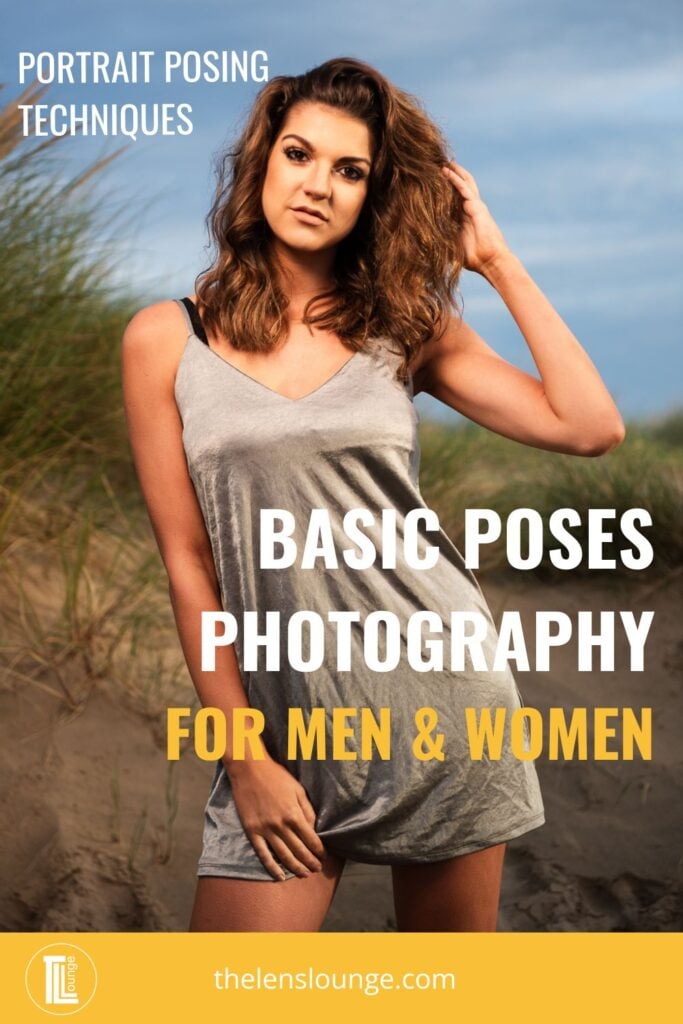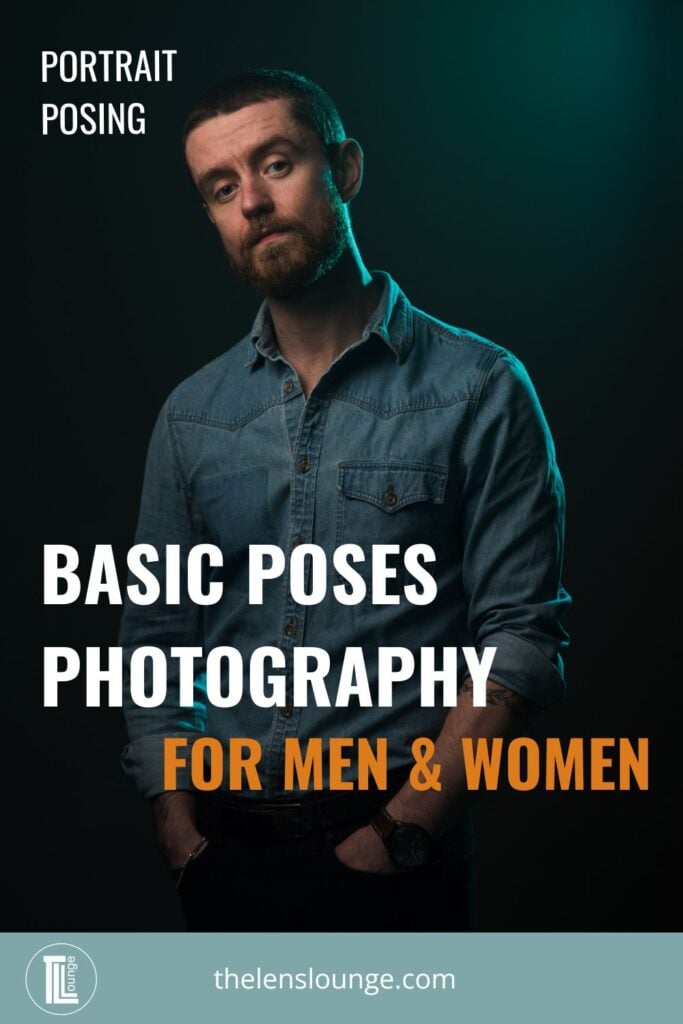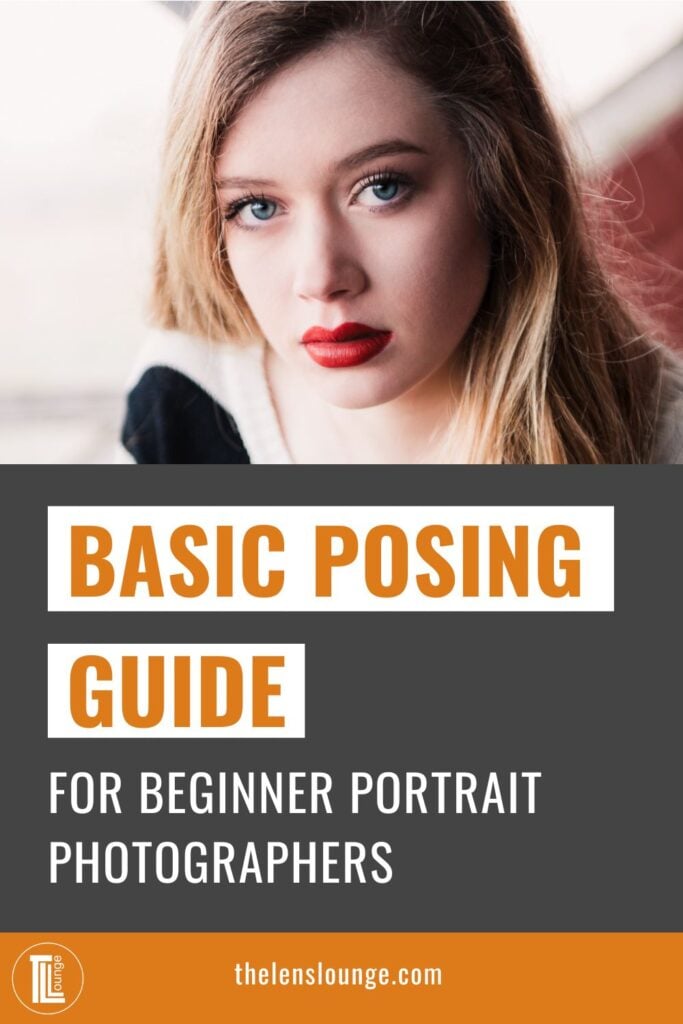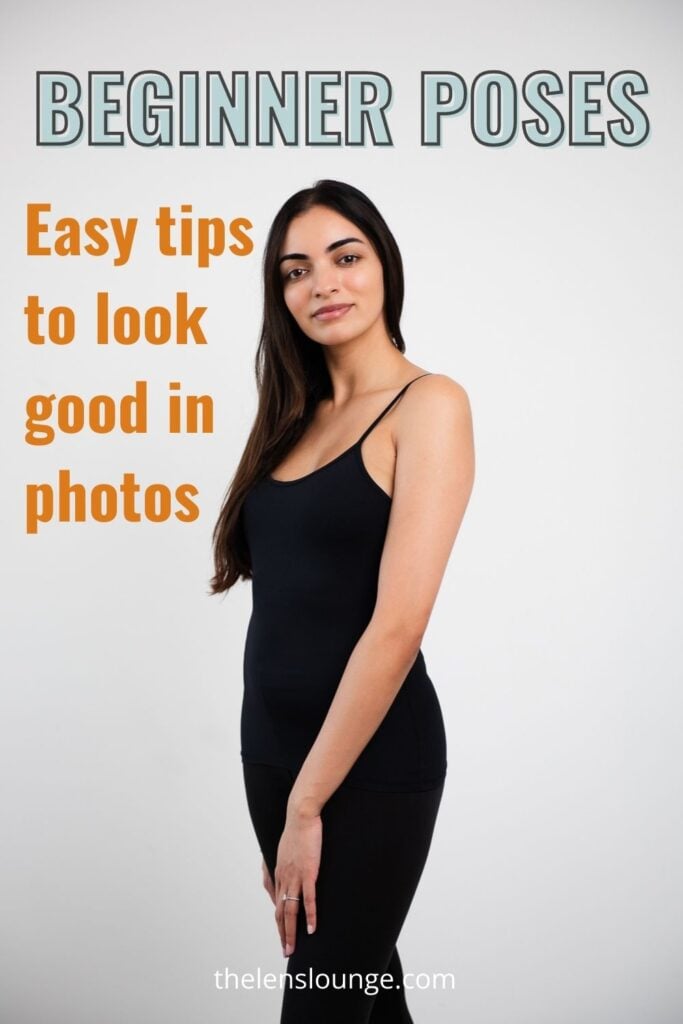Portrait photography has changed a lot in the last couple of decades, because of digital cameras and particularly the eye autofocus ability of mirrorless cameras. The result is a change in how we pose portrait subjects and many photographers don’t know even basic poses for photography.
As anyone who has ever scrolled through Instagram knows, many portrait photographers now prefer lifestyle photography and pose prompting to get natural poses, rather than formal portrait posing.
However, not every photoshoot suits running hand in hand on a beach, a walk in the woods or rolling around in the grass.
Knowing how to pose people makes you more versatile as a portrait photographer, because even with basic posing knowledge you can make people look better in photos. And who doesn’t want that?
So there’s still huge value in learning basic poses for photography.

Basic posing tips for photos
Putting a non-model in front of the camera is like putting a shy person center stage at a rock concert – they get stage fright. Left to their own devices they’ll look like it.
It’s your job as a portrait photographer to use posing to make people look good in photos and say what they want to say.
Today we’re looking at the basics of posing men and women. For more detailed guides on posing women for photos, read:
Female model photography poses
(I’ll update the list with guides on posing men once I’ve written them.)
Type of portrait – what’s the photo context?
The first rule of portrait posing is that the context of the photoshoot determines the type of poses to use. Model poses won’t suit a headshot session with the CEO of a bank. I mean, it would be fun if we could do that, but the CEO wouldn’t be taken seriously.
Who is in the photo
Posing women is different from posing men, even if you want the photo to communicate the same message.
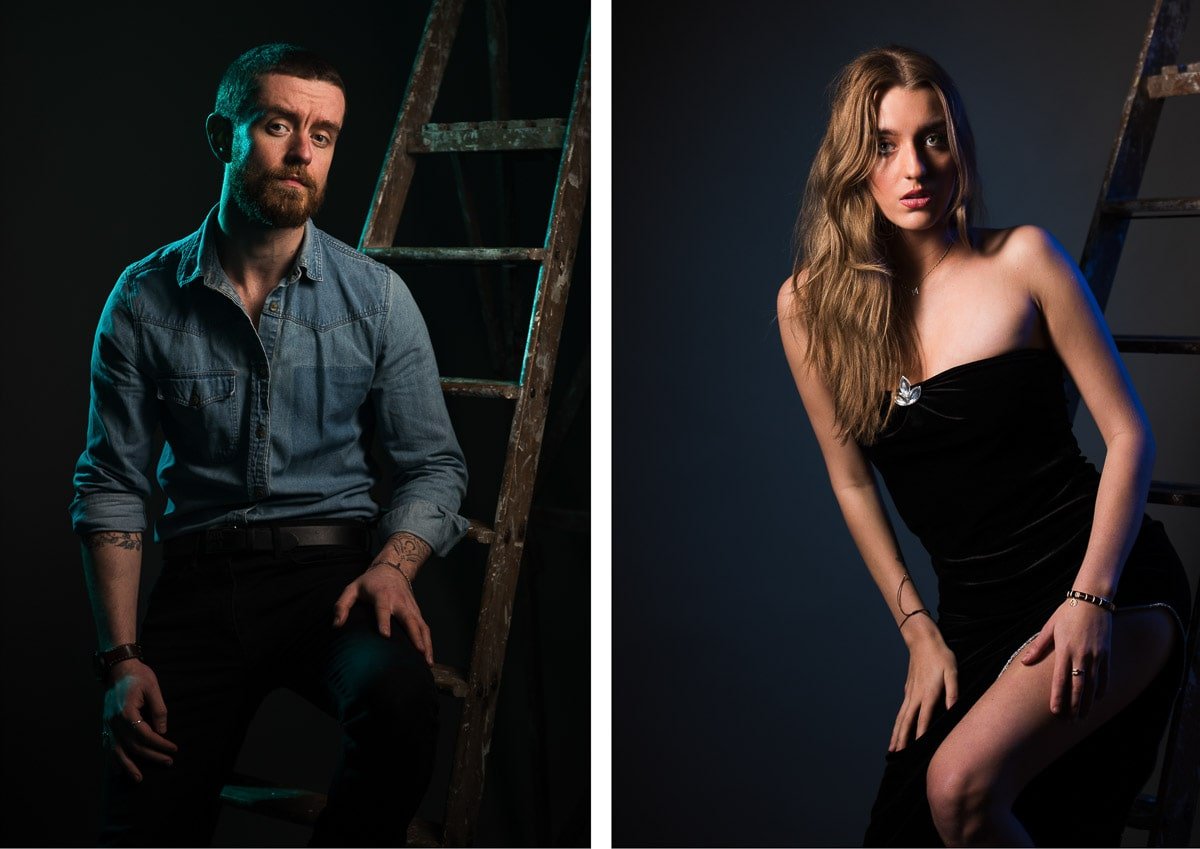
Posing men and women – the differences
You can’t use the exact same poses for men and women in portrait photography.
But if you remember these basic posing principles, you can adapt all poses to suit either men or women.
Body position – male vs female poses
- Most male poses are quite comfortable as a slightly slouched body appears broader
- Most female poses involve effort for the subject, because they’re based on creating curves and good posture is slimming
It’s not fair, but it’s true.
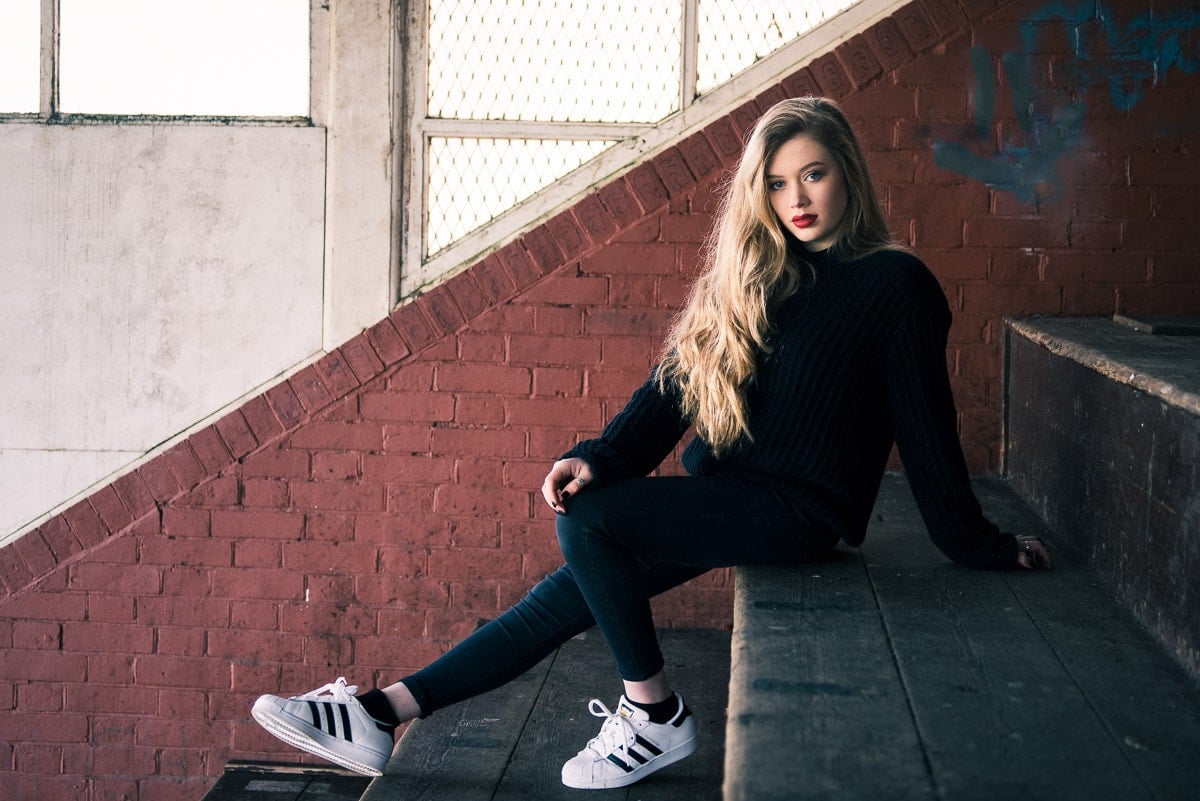
Shapes to use for male vs female posing
A helpful posing technique is to think in terms of shapes for basic photography poses for men and women.
Not only does it help you to remember good poses, but shapes are an important element of composition.
Using triangles and curves in photos creates more interesting shapes than straight lines for the viewer as our eyes follow the line of shape. Limbs are a great way to add these elements of photography composition.
- For men – think inverted triangle – wide shoulders narrowing to the hips
- For women – think curves, specifically an S-curve (the shape of the letter S) – it’s a classic pose for women that creates a flattering and feminine look
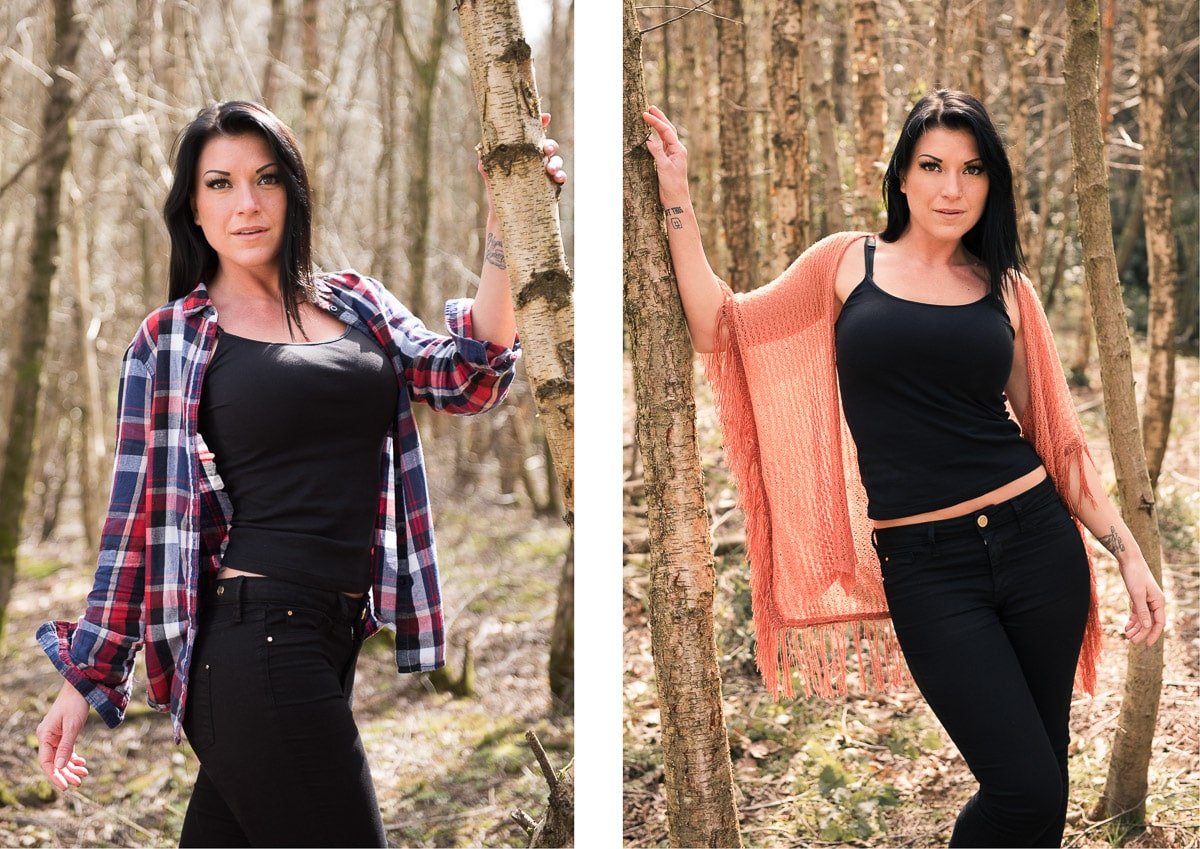
Examples of s curve posing for women
Slimming poses for portraits
The three rules of slimming poses you need to remember for posing women and men:
- To make something smaller, move it away from the camera lens. Bring it towards the lens to make it bigger
- Reduce a person’s width by angling them slightly sideways to camera, rather than front on
- Allowing space between the arm and the body makes a person appear slimmer in front of the camera
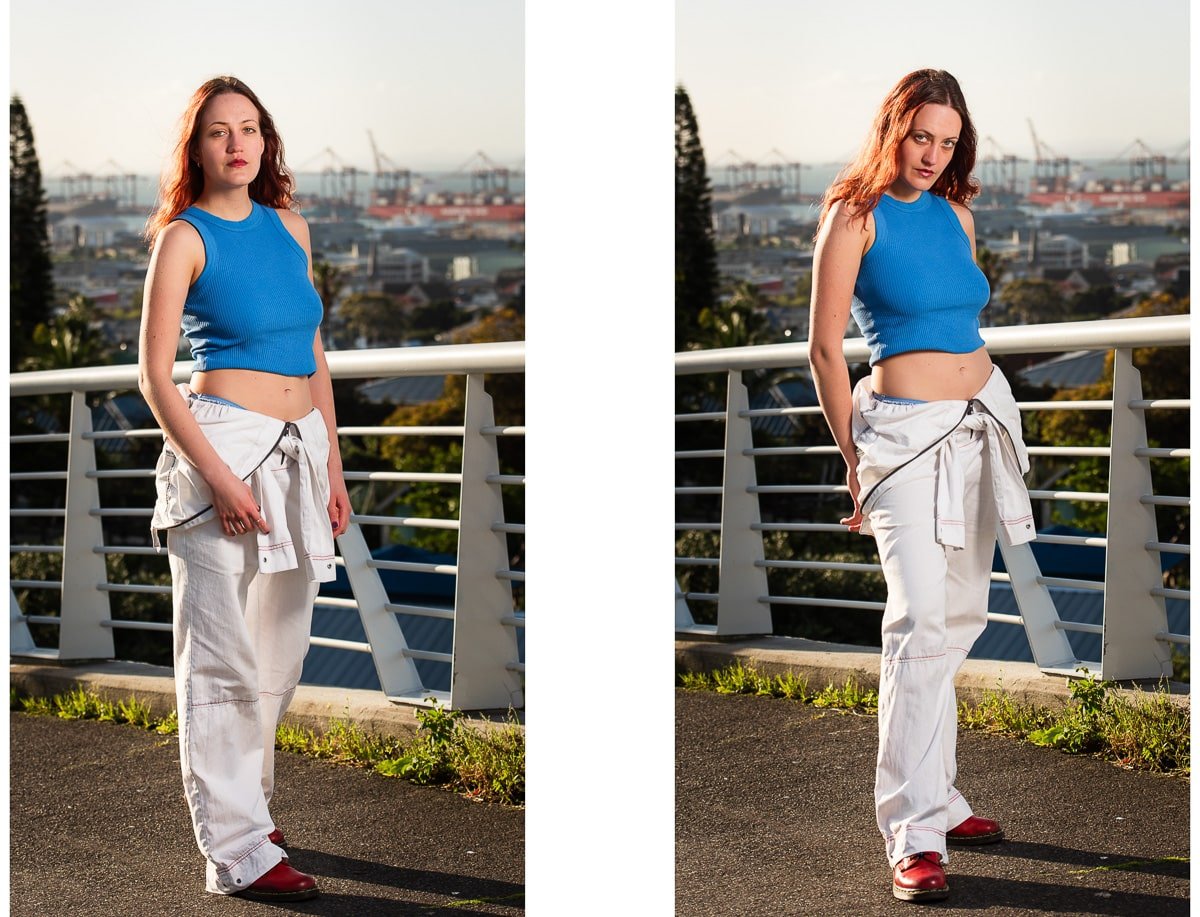
On the left she has her weight on the front leg (closest to camera), but on the right she’s shifted her weight to her back leg, which instantly reduces her waist
Here’s a basic slimming pose that works for most female body types (demonstrated above):
- Stand at a slight angle to the camera
- Weight on the foot furthest from camera
- Hips popped back slightly

A great basic female pose to slim hips by popping the hips back and leaning forward slightly from the hip
Slimming poses for different body shapes
Good portrait photographers direct poses with the subject’s body shape in mind.
Plus, posing isn’t always about slimming curvy people, sometimes it’s also about creating curves. (This is the part where you use your basic posing knowledge to make people look good in photos.)
- Pear-shaped body – lean towards the camera from the hip closest to camera to slim hips. It’s a very slight movement – I tell my clients to lean towards me as if they didn’t quite hear me.
- Apple-shaped body – to slim the torso and define the waist pop the hip of the back leg to the side, hand on hip, with the opposite hand crossed slightly over the body and resting gently on the thigh of the front leg.
- Rectangular-shaped body – create the illusion of curves by popping the front hip up a bit so that it’s slightly higher than the other and rest the hand on the front hip.
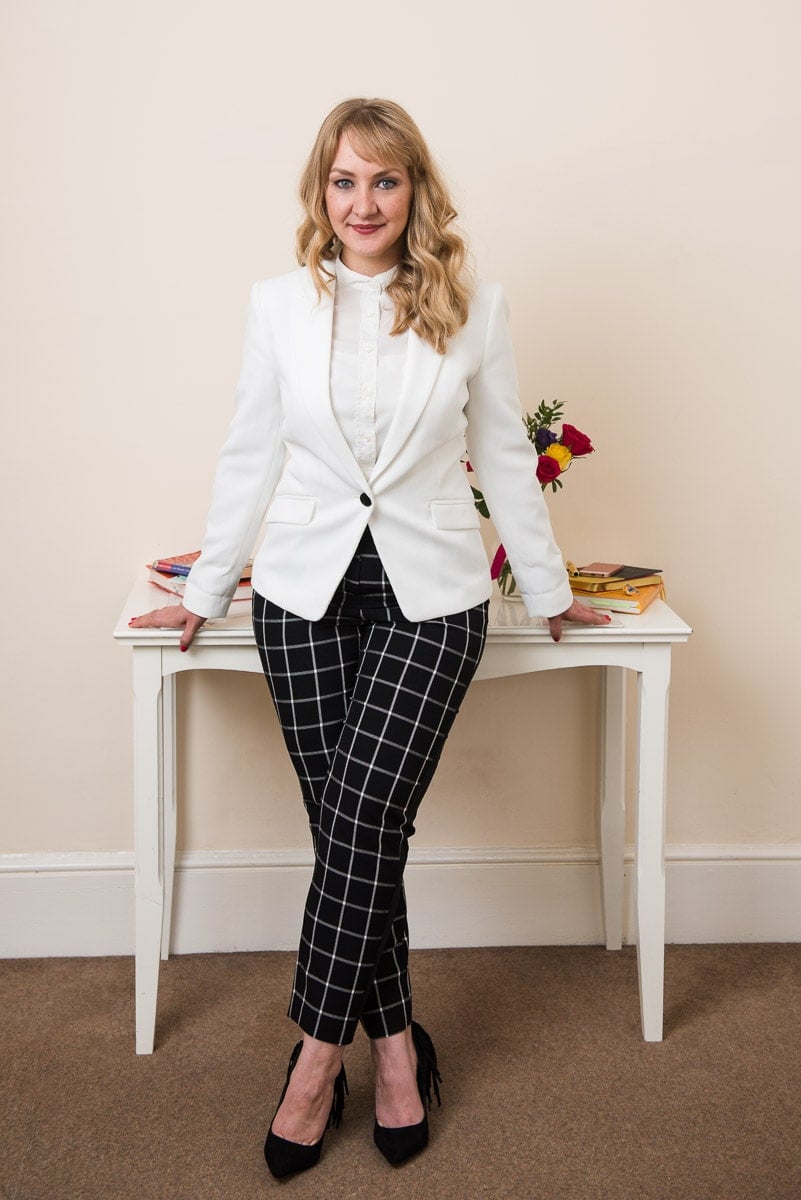
To slim legs in photos when a subject is facing towards the camera, ask them to cross one foot over the other so their legs form an X shape. Plus, popping the hips back slightly, away from camera, makes them slimmer.
Body language in poses
We use poses to speak in photography.
So, to be a good portrait photographer you need to develop your body language skills. For example:
- Confident people take up space, so confident poses are big poses
- If you’re interested in what someone has to say you lean in and when you’re not you lean away from them. Just a slight lean towards or away from the camera sends the same message.
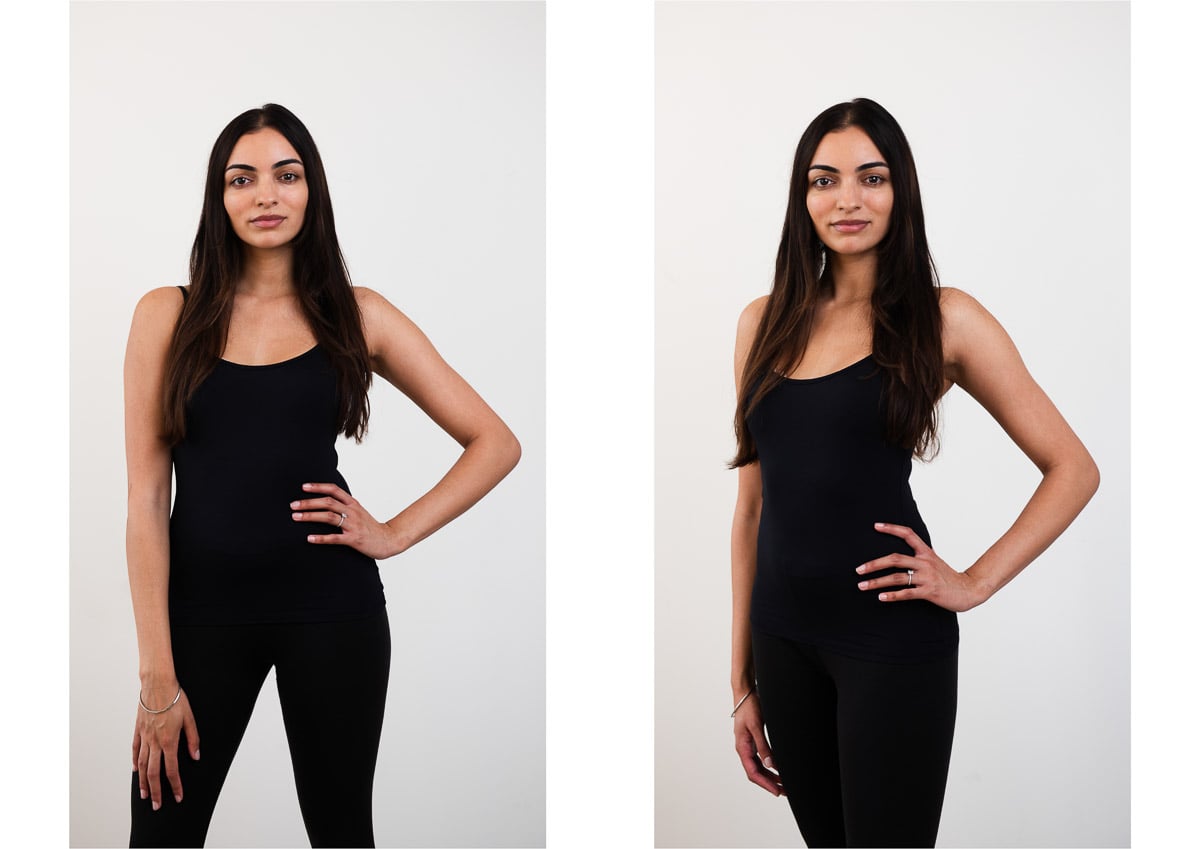
The poses are similar, but in the image on the left is both more assertive and less slimming than the image on the right
Body language of pose direction
Just like in life how a person is positioned in a photo in relation to the camera speaks volumes.
Facing directly towards the camera is assertive and often considered confrontational. This isn’t necessarily a bad thing, as long as you know the impact of the pose on the message of the photo. Tweak the pose to reduce or increase the level of confrontation.
Angling the body slightly away from camera removes the confrontation and invites the viewer in.
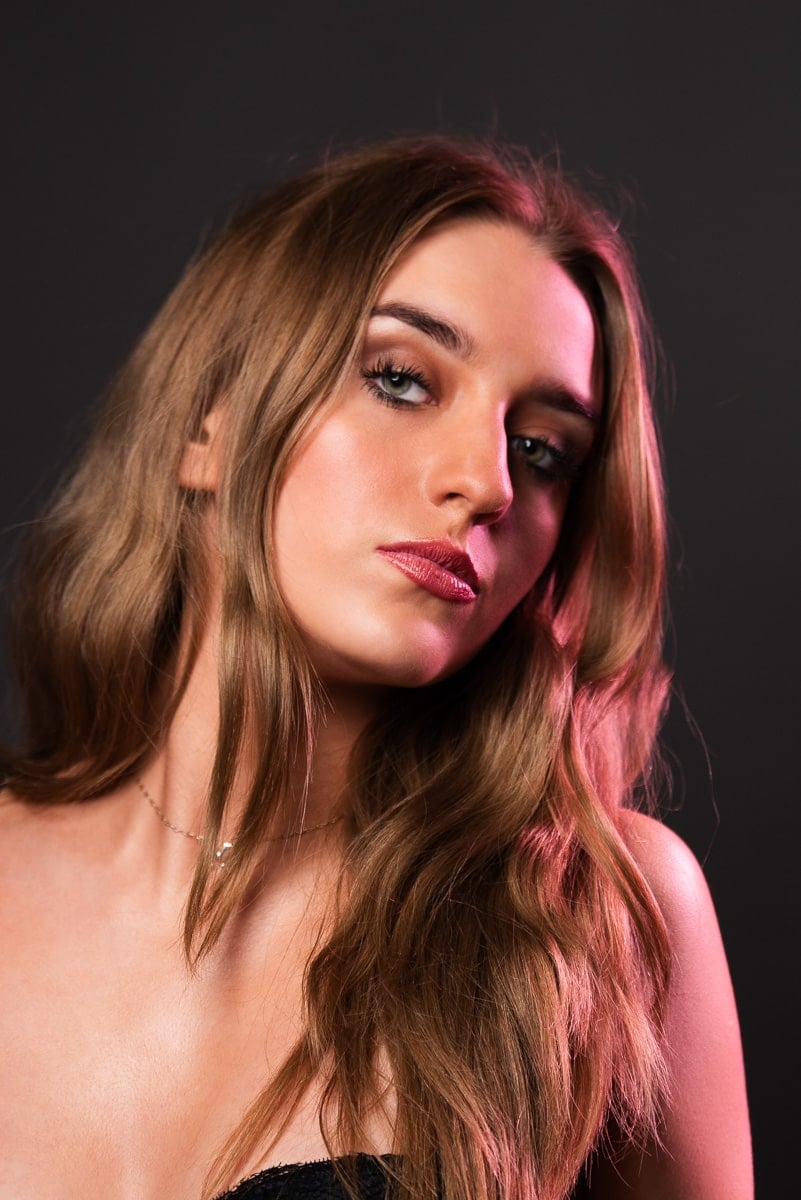
Head position body language
To reduce the appearance of a large forehead, you’d get your subject to tilt their chin up slightly. This increases the size of the chin and reduces the size of the forehead.
However, head position in photography posing isn’t always about looking good in photos.
- Tilting the chin up slightly – makes the subject appear more confident. Taken too far and they appear arrogant or over confident, as they’re quite literally looking down their nose at the viewer.
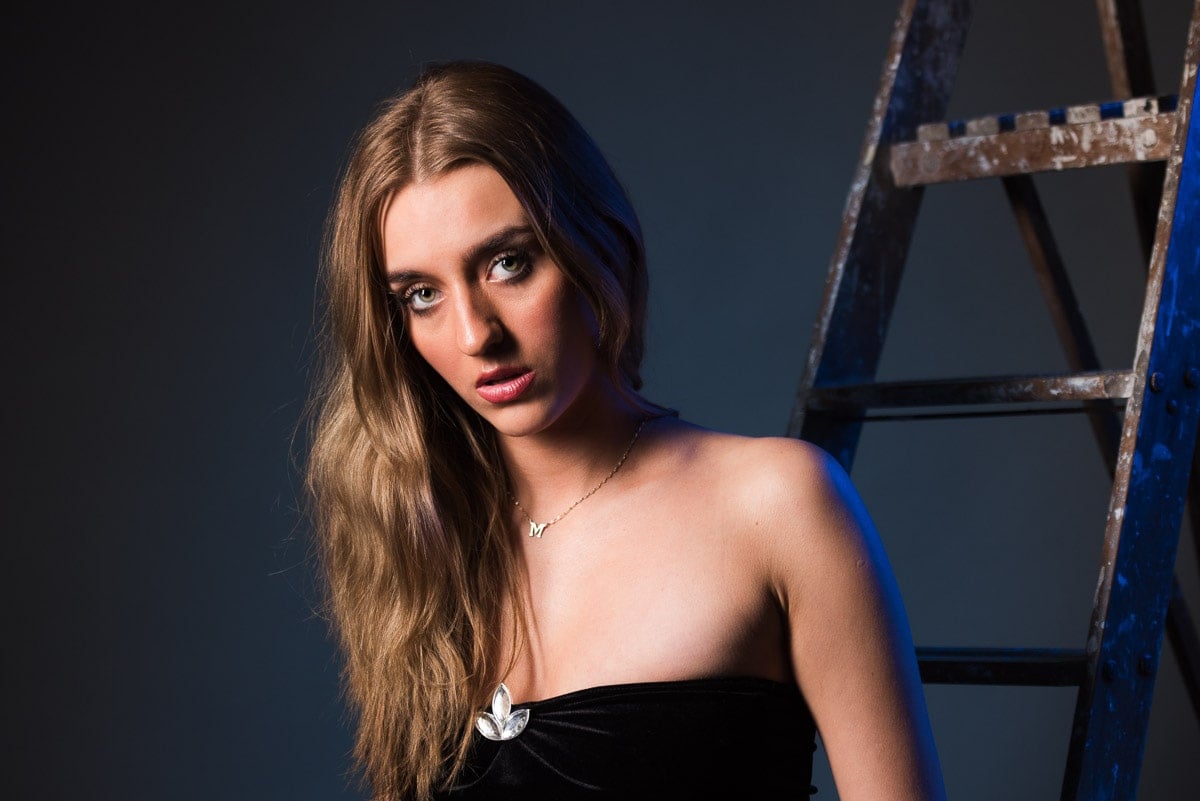
- Tilting the chin down – is more deferential as the subject looks out of the top half of their eyes at the viewer. Taken too far an adult can appear child like and submissive – think of Oliver Twist when he says “Please sir, I want some more”.
This applies to both male and female poses.
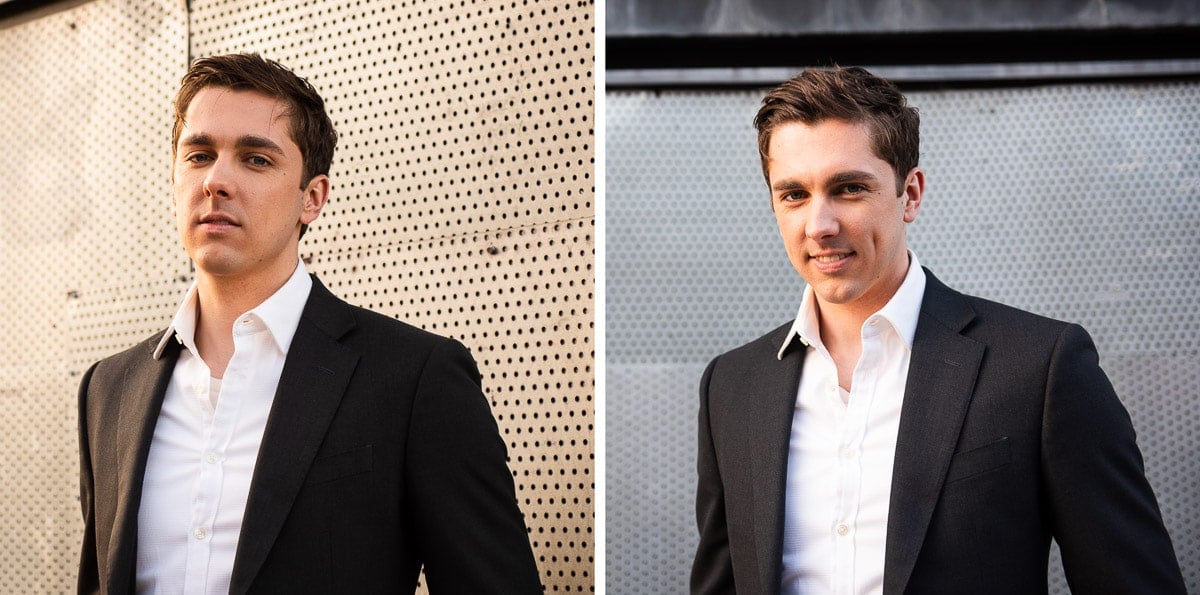
Whatever look or message you’re going for with the pose, remember to make sure that facial expressions match the pose.
Head position in traditional male and female poses
When the subject is slightly side on to camera, angling the head toward or away from the camera also changes the feeling in a photo.
Of course you don’t have to stick to traditional gender roles in photography posing, but tilting the head one way or the other creates different energy.
- Angle the head away from camera for traditional male poses
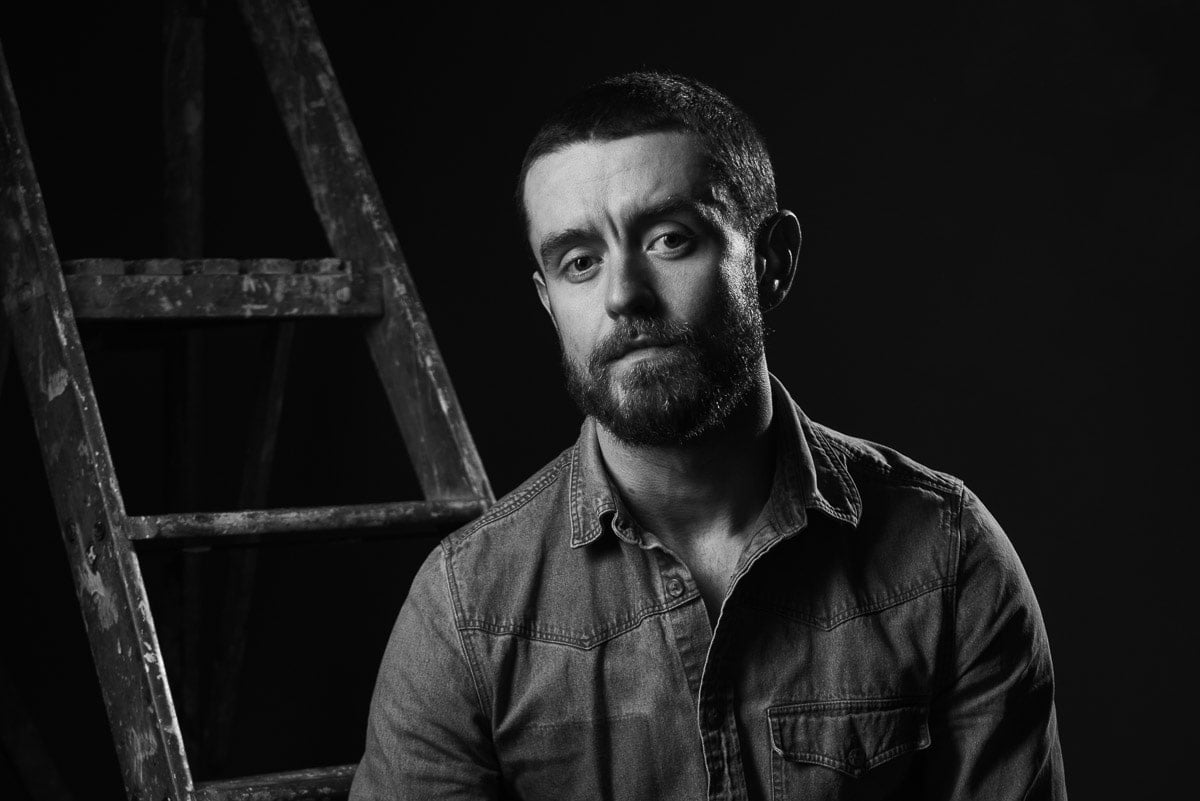
- Angle the head toward camera for traditional female poses
Pro posing tip: To help direct a head tilt I tell my clients to bring their ear either away from or closer to the shoulder closest to camera.
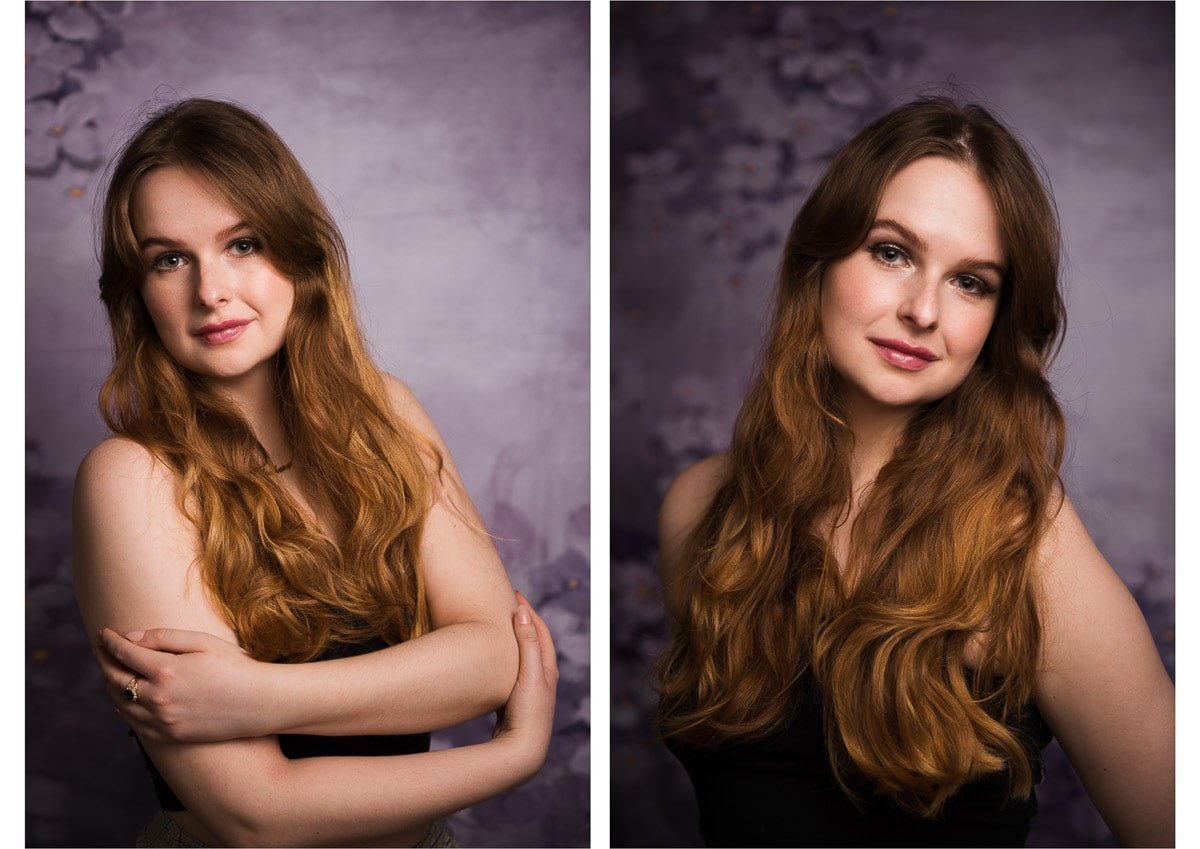
Basic photography poses with folded arms
We all know that crossed arms is confrontational body language. In photography posing, how you cross the arms makes a huge difference and can change a photo pose.
- Comfortable and friendly (see above left)
- Calmly in control – elegant arms with relaxed hands (see below)
- Assertively in command – firm arms and hands
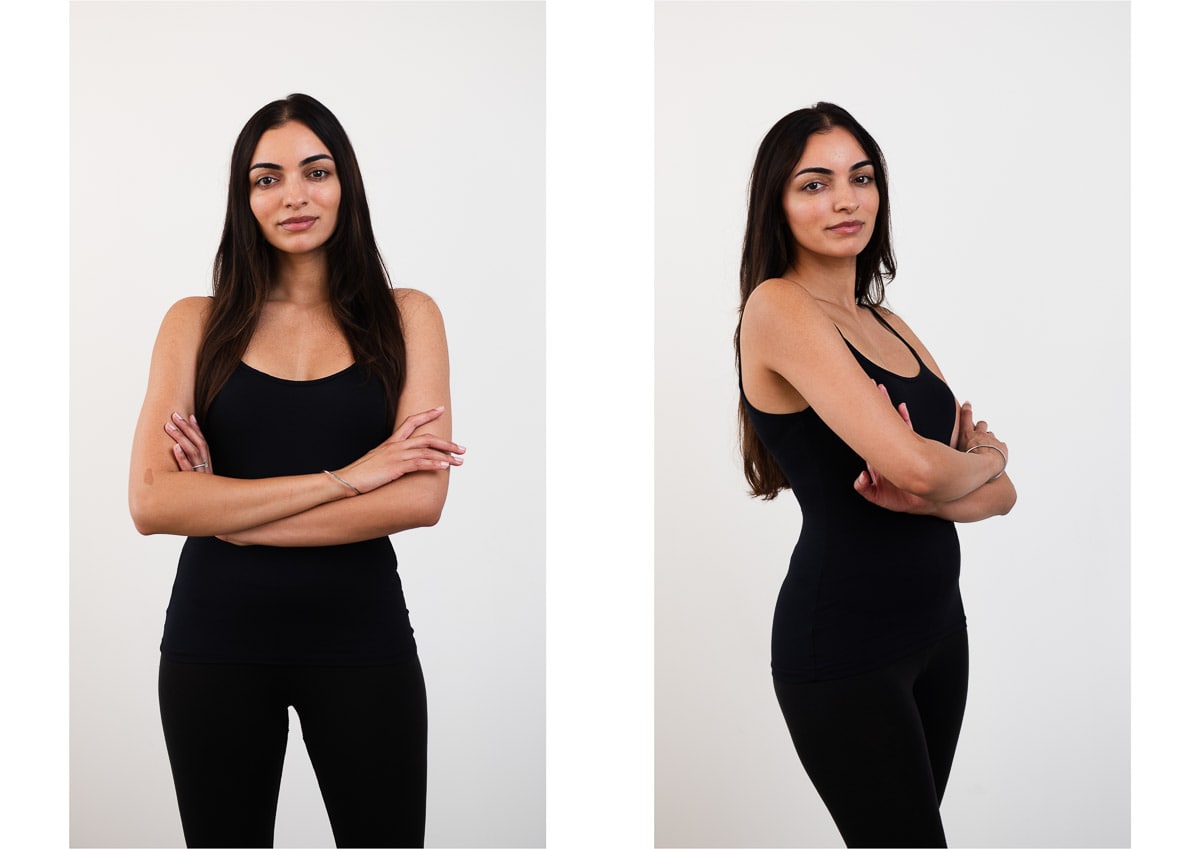
The image on the left is more assertive than the image on the right, although it’s almost the same pose
3 asymmetrical poses for men and women
The golden rule of posing limbs in photos is that if it bends, bend it. But don’t bend everything all at once just because of vague posing rules. Here’s why…
Limbs are a great composition tool in portrait photography. I mentioned limbs earlier with regard to creating interesting shapes, but they’re also great to use as balance in composition.
- Symmetry establishes order
- Asymmetry makes composition more dynamic
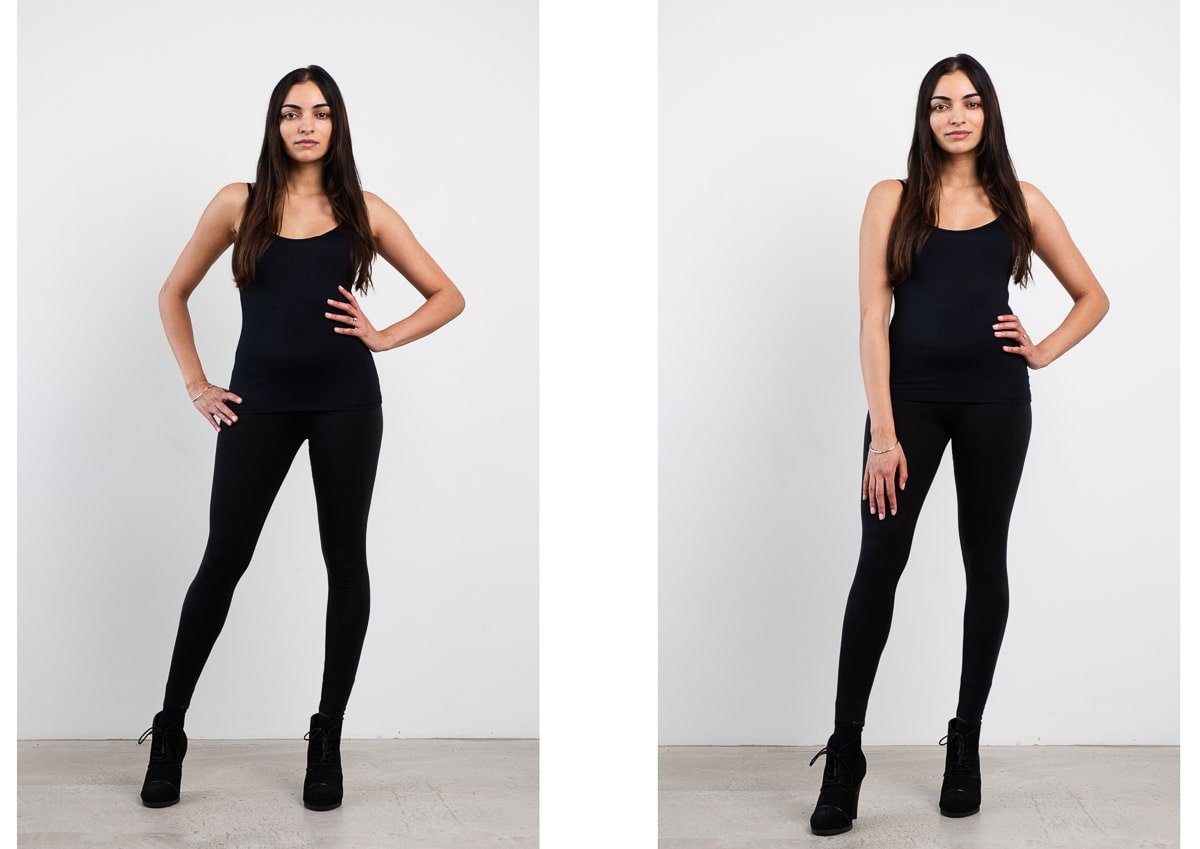
Asymmetrical pose 1
Put a hand in a pocket or on the waist and let the other arm hang loosely next to the body (with a little space between arm and body)
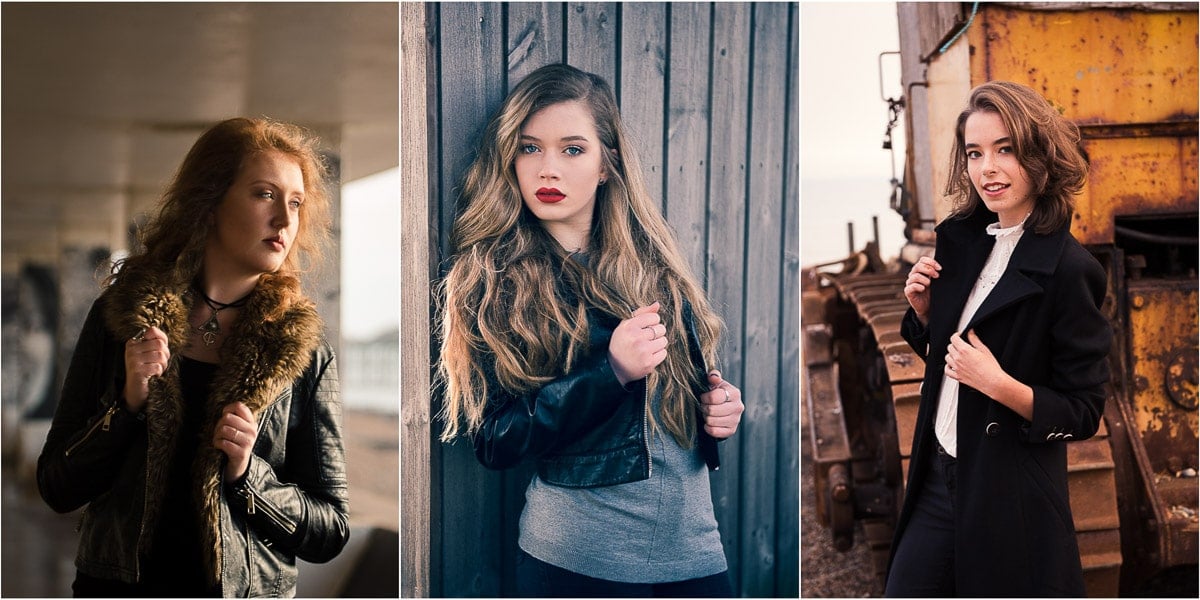
Asymmetrical pose 2
Hold onto jacket lapels, but have one hand placed higher up than the other.
It works just as well with basic male poses.
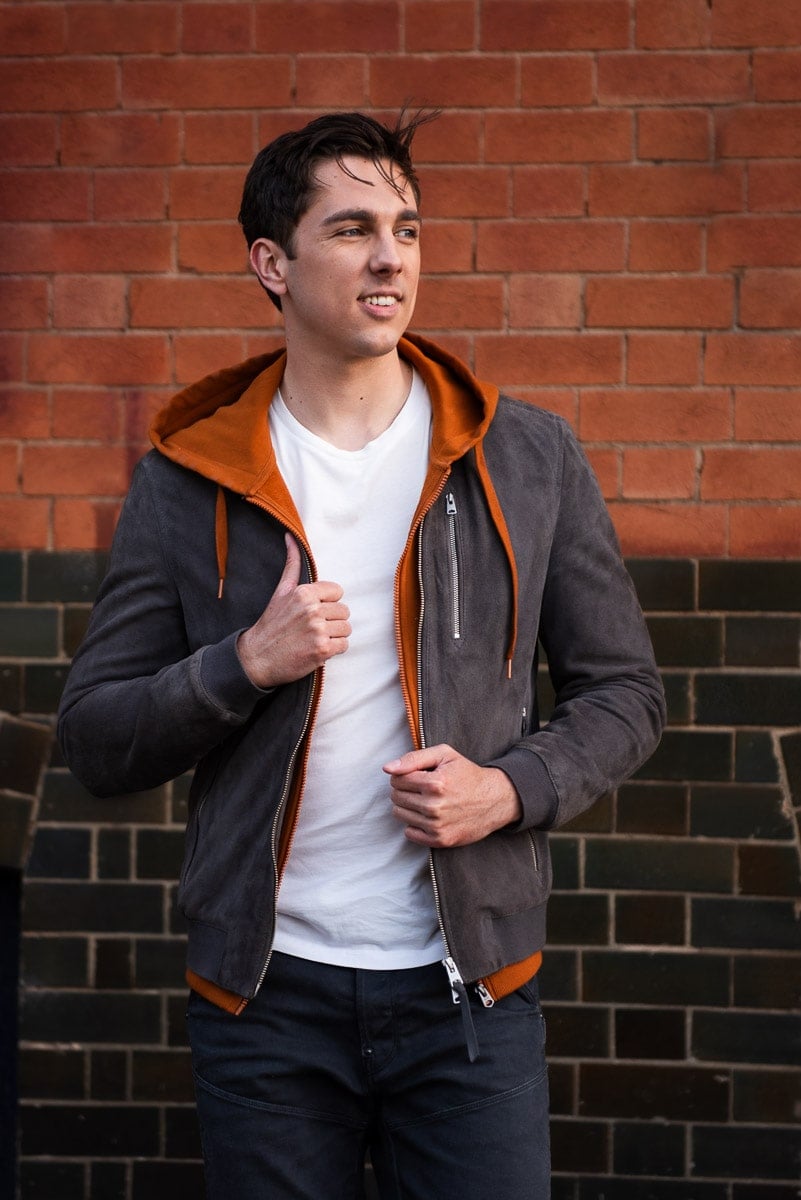
Asymmetrical pose 3
Female pose – bring one hand up to the collar bone, or in the pocket, and the other brushing back a strand of hair
Male pose – put one hand in a pocket and the other brushing back hair or behind the neck
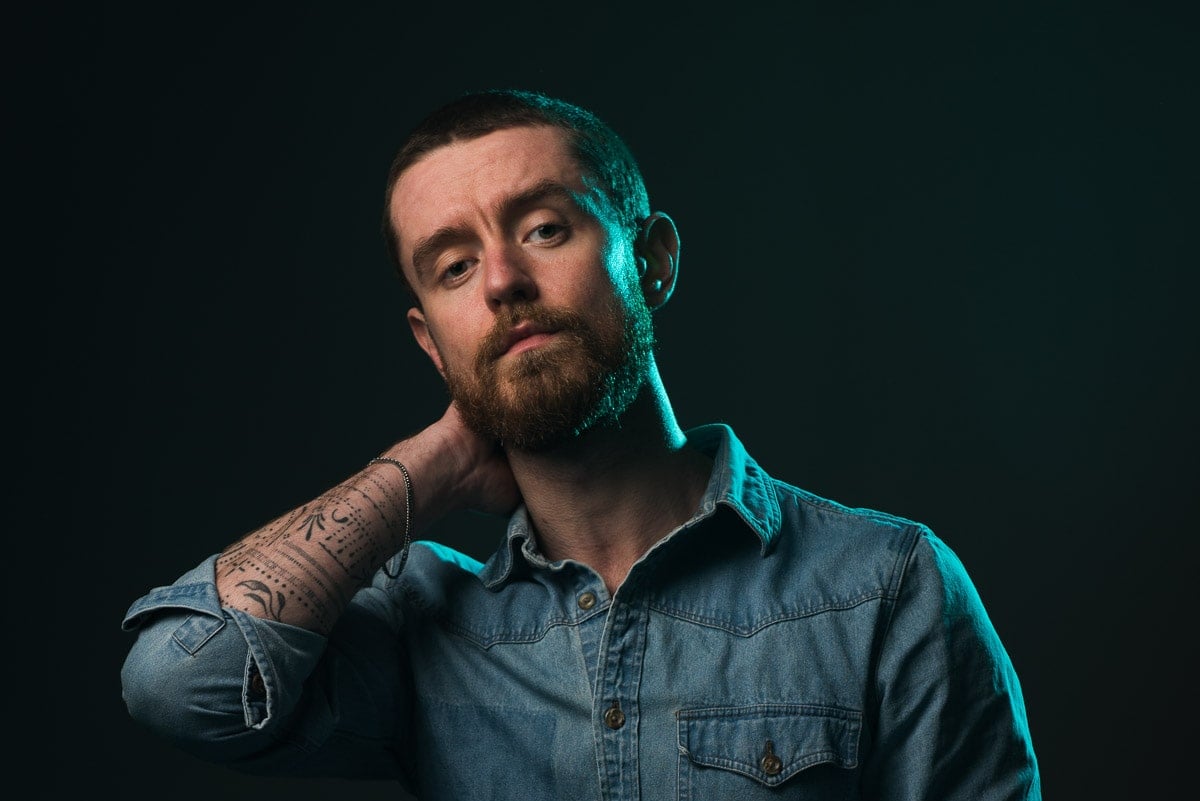
Hand position in poses
Hands are very obvious in photos, so hand placement has more impact than you may realise.
- For female poses, avoid having the back of the hand to camera – it makes the hand larger. Rather position the blade of the hand (the side that the little finger is on) facing camera. For added elegance tilt the wrist and bend the fingers slightly.
- For male poses, large hands are considered fine, so you don’t need to worry about not showing the back of the hand. However, be careful not to let the hand form a fist if you don’t want to send an aggressive message.
- When two hands are joined in a photo, direct them not to intertwine their fingers as you end up with a big, distracting ball of fingers.
Pro posing tip: always pay attention to hands in photos!
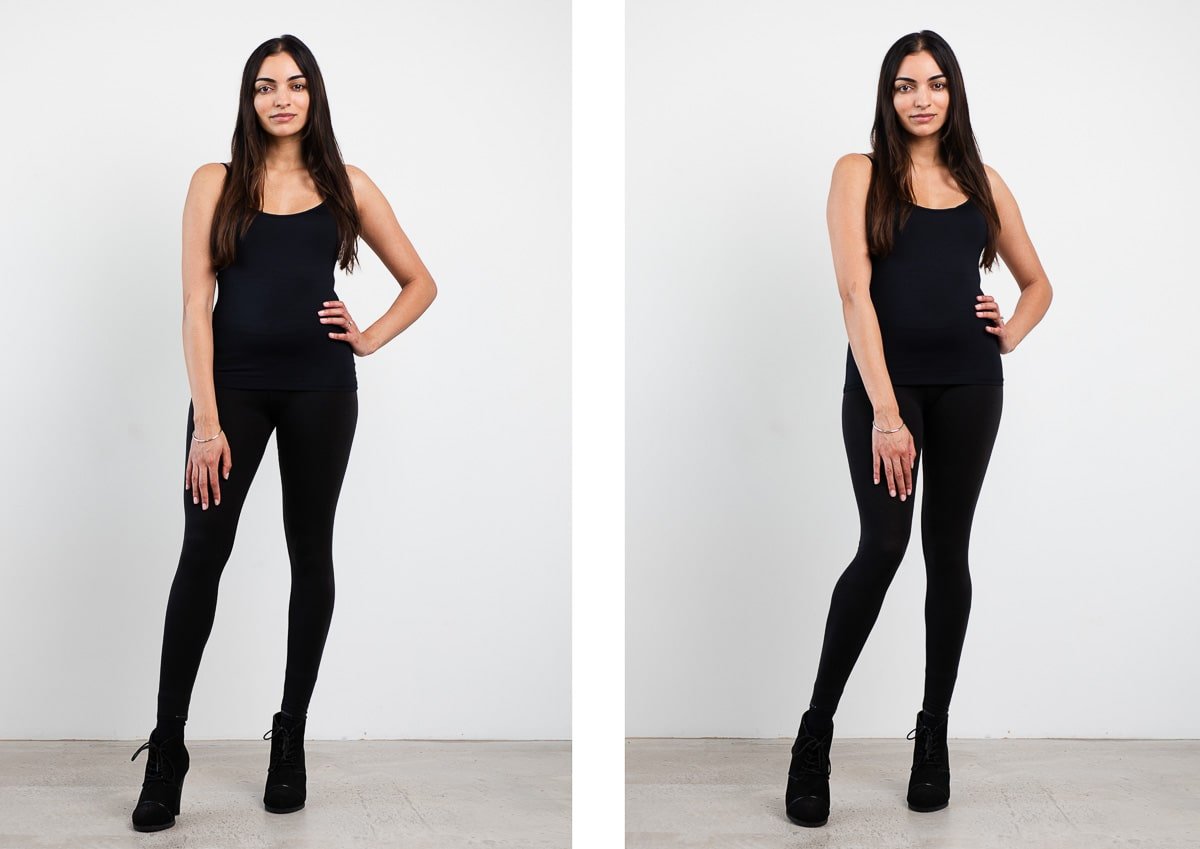
Feet position in photos
Firmly planted feet conveys confidence and assertiveness, but does your subject look good in that pose? If not, ask them to angle slightly sideways to camera so they can look confident and good at the same time.
Putting the weight more on one foot than the other creates a more relaxed pose and is also flattering for both men and women.
Camera angle impact on posing
The trick with using camera angles in portrait photography is to consider the message. How do you want the viewer to feel when they look at the photo?
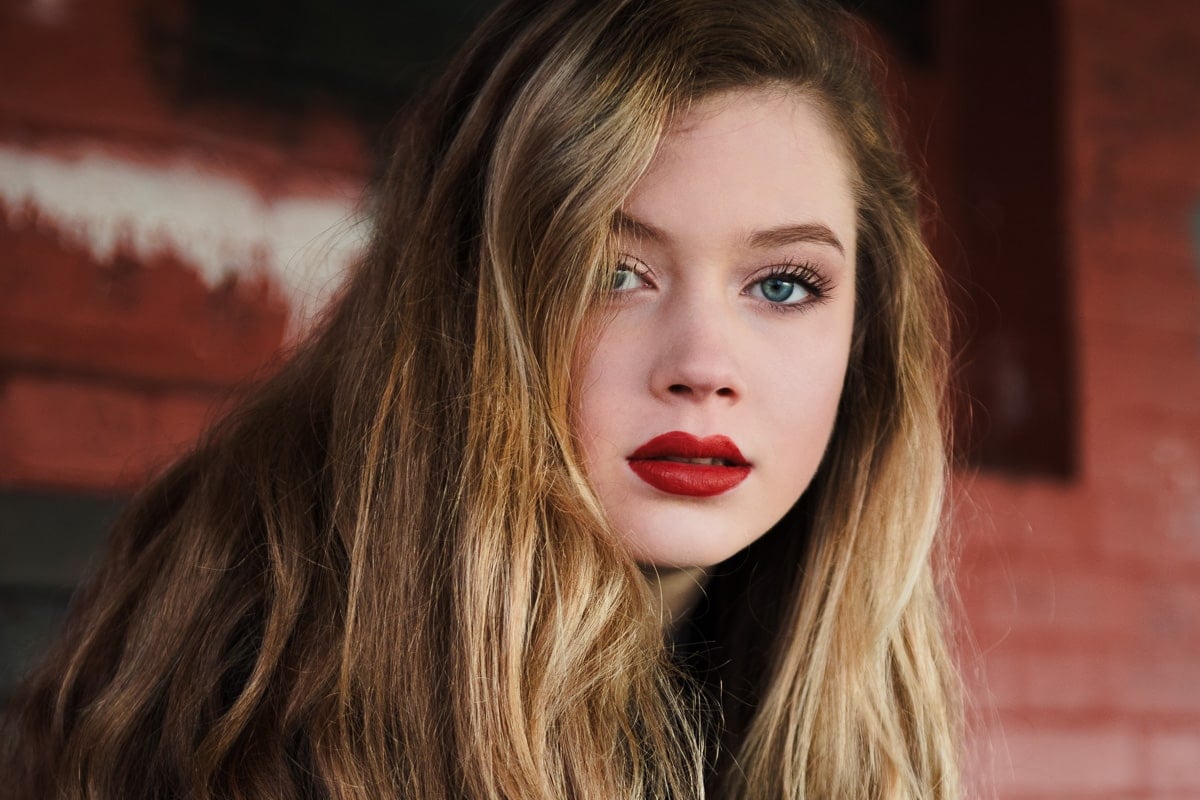
Low camera angle
When you kneel and photograph up towards the subject you place them in a dominant position, whether they’re sitting or standing.
Be aware of the subject’s legs and the impact of lens focal length with a low camera angle in full body poses. If you use a wide angle with the subject towards the center of the frame you’ll make their legs long, which can be flattering and interesting.
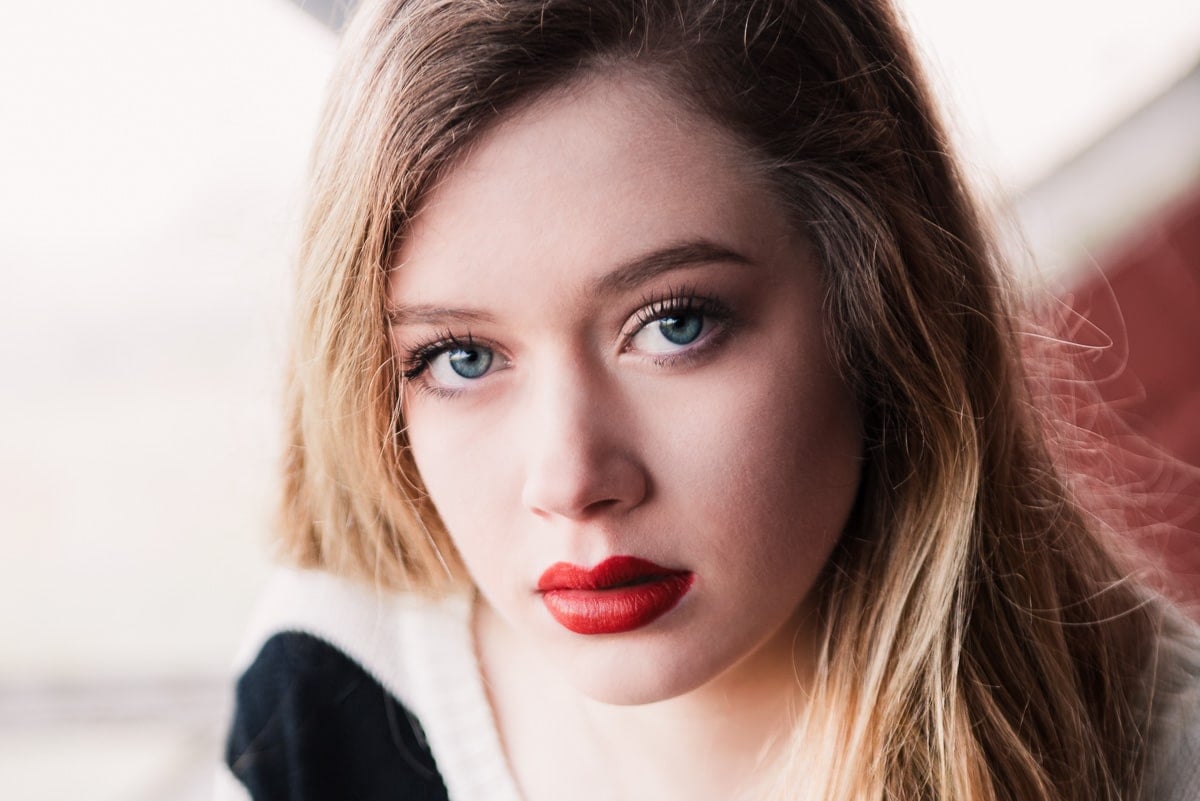
High camera angle
When the photographer is higher than the subject and photographs down on them it puts the viewer in a dominant position looking down on the subject.
With a full body pose photographing from a high angle makes the body smaller as it’s further from camera than the head.
So be careful when choosing focal length so that you don’t lollipop the subject with a wide angle. This is where the head appears too large for the body. Or, if you’re feeling creative and it suits the shoot, it could be a fun camera angle.
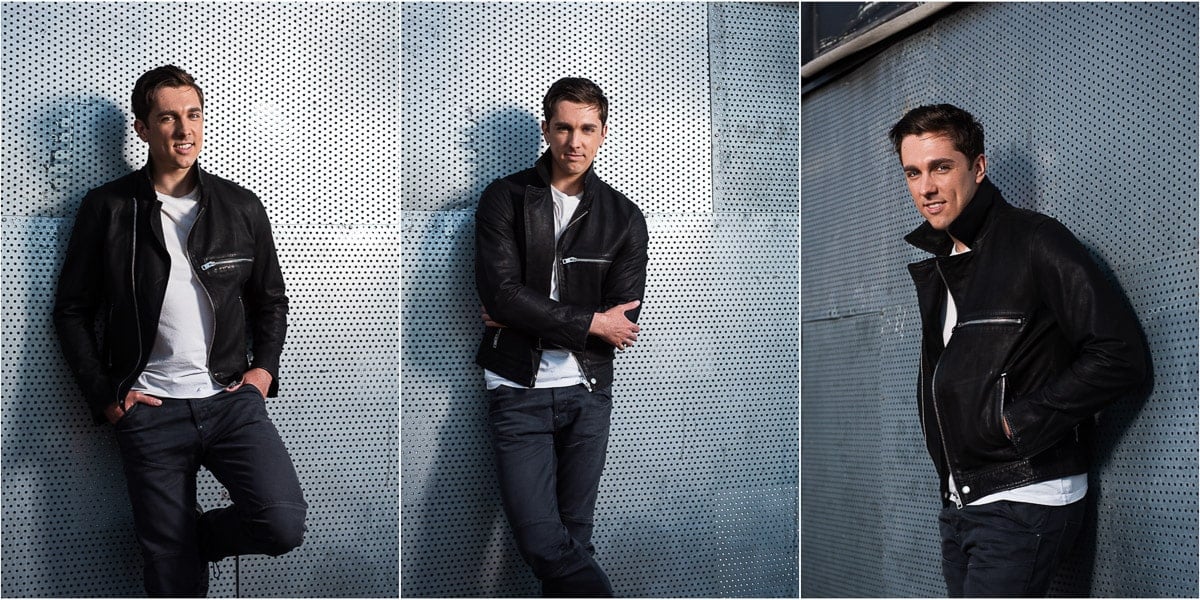
When you pose somebody leaning against a wall or tree, remember to move around them and photograph from different angles for quick variety of poses. Also, to maximise variety, capture poses with different feet positions and hand positions before you move on.
Tips for different types of portrait poses
Standing pose tips
Full-body shots with standing poses require more thought and attention than other types of poses, because you’re photographing the entire body.
- When posing women – pay attention to the whole body and think about curves
- When posing men – focus on the upper body and create strong and powerful poses
Pro posing tip for standing poses: We all have a favorite side, but nobody can tell you off the top of their head which side that is. Ask your subject to imagine they’re standing in a queue and they’ll automatically shift their weight to their favorite stance.
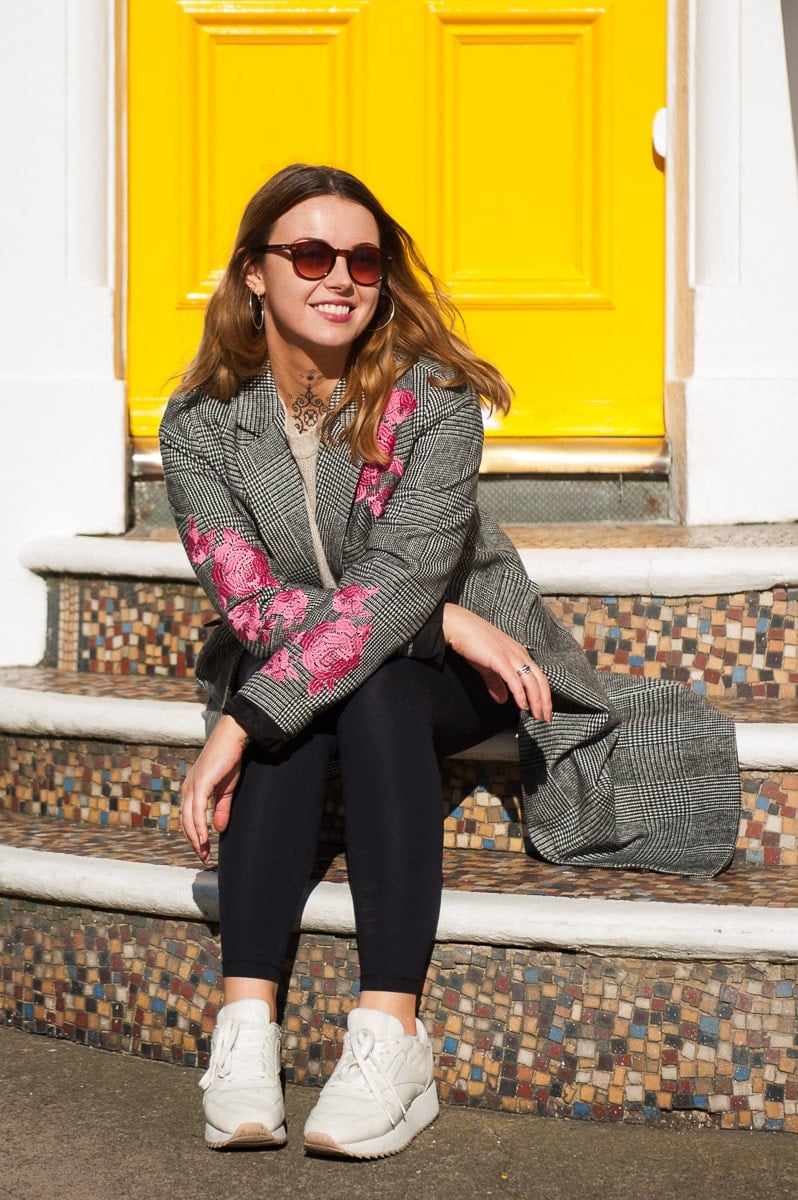
Sitting pose tips
It’s very easy to foreshorten bodies in sitting poses and for women to lose their waist. The best way to avoid this posing mistake is to angle the subject slightly sideways to camera. Are you picking up a trend yet?
For a female sitting pose facing towards camera you can ask her to lean forward and cross her elbows over across the waist to create a fake waist.
Pro posing tip: Sitting on the edge of a chair is more slimming on legs. When I ask my female clients to “perch” on the edge, rather than sit comfortably, they instantly know what I mean.
Basic photography poses final tips
These posing tips apply whether you’re photographing men, women, or groups of people.
- Practice makes it easier, so I’d suggest working through poses in front of a mirror before you try to direct portrait subjects into poses
- You’ll get used to how the pose feels, which makes it even easier to direct
- Demonstrating poses as you direct your subject is much easier for your subject to understand what you’re saying
Portrait photography posing is more than memorizing different poses. You need to:
- Be conscious of the message you want to convey
- Understand how a camera works for the best angles
- Realize that small changes make a big difference to a pose
You don’t need to know all the best poses straight away.
First, build a collection of simple poses for individuals for different types of photoshoots, body types, ages and genders. Then use those same principles of posing and move onto posing couples and groups.
Leave a comment
If you have any questions about basic portrait photography poses, let us know in the comments.
Also, I love good news, so if my posing tips have helped you, share that too.
